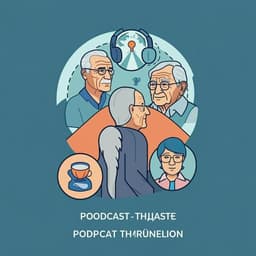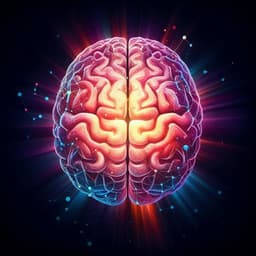
Psychology
Oscillations of the Wandering Mind: Neural Evidence for Distinct Exploration/Exploitation Strategies in Younger and Older Adults
C. N. Moran, D. P. Mcgovern, et al.
This study traces neurophysiological signatures of shifting attention and task-related processing to reveal how transient strategic switches between task focus and mind-wandering differ with age: older adults show steadier attentional engagement and exploitative strategies while younger adults display greater exploratory mind-wandering. Research conducted by Catherine N. Moran, David P. McGovern, Mike Melnychuk, Alan F. Smeaton and Paul M. Dockree.
~3 min • Beginner • English
Introduction
The exploitation/exploration trade-off posits alternation between exploitative, goal-directed processes and exploratory modes such as mind-wandering. While mind-wandering can benefit creativity, memory, and planning, effective performance requires flexible regulation between exploit/explore strategies. Age-related changes in executive resources and catecholaminergic systems may constrain exploratory shifting in older adults. The locus coeruleus–noradrenaline (LC-NA) system, indexed by pupil diameter, is implicated in attentional control and may regulate temporal oscillatory attention cycles. This study asks whether younger and older adults strategically prioritize task focus versus self-generated thoughts during a non-demanding sustained attention task, and through which neurophysiological mechanisms. Hypotheses: older adults would deploy a more exploitative strategy and conservative decision policy; younger adults would permit greater exploratory mind-wandering. Psychophysiological markers examined include EEG alpha and pupil diameter (attentional engagement), SSVEP (sensory processing and perceptual decoupling), CPP (evidence accumulation), and left hemisphere beta (motor preparation).
Literature Review
Prior work suggests mind-wandering can be beneficial (creative incubation, problem solving, memory encoding, prospective planning), but also relates to performance variability and errors. RTV tracks oscillatory attention cycles and is often more pronounced in younger adults. The adaptive gain framework links LC-NA dynamics and pupil diameter to exploitation/exploration balance with inverted-U performance relations. Ageing entails declines in executive control and neuromodulatory tone, potentially limiting exploratory flexibility; yet preserved LC neuronal density relates to better cognitive status with age. Perceptual decoupling literature reports attenuated sensory processing (e.g., reduced P300, cortical phase locking) during mind-wandering, elevated posterior alpha before lapses, and pupillometric changes accompanying exploratory shifts. Diffusion model studies show wider, more conservative decision bounds with age. These literatures motivate testing age-related differences in oscillatory strategies during sustained attention.
Methodology
Participants: 35 younger adults (18–35) and 40 older adults (65–80) were recruited; exclusions for data quality and MoCA <24 led to final neurophysiological sample of 34 younger (16 female; mean age 21.71, SD 4.59) and 34 older (20 female; mean age 70.97, SD 3.54). Groups did not differ in sex or education. Procedure: Gradual Contrast Change Detection with Experience Sampling (GradCCD-ES) in a dark, sound-attenuated room with chinrest at ~57 cm. Continuous 25 Hz flickering checkerboard annulus (outer radius 8°, inner 3°) on CRT 100 Hz. Targets: gradual contrast reductions from 65% to 35% over 1.6 s, with return to baseline after 0.8 s; ITIs randomly 3, 5, or 7 s. Participants responded via speeded mouse press on detection. ES probes occurred pseudo-randomly (minimum 2-trial separation), after 500 ms blank, asking whether thoughts were (1) Focused, (2) Unintentional mind-wandering, (3) Intentional mind-wandering; intentional/unintentional were collapsed as Mind-Wandering for neurophysiology. Eight blocks; each had 48 targets and 16 probes (~8 min/block) with brief breaks. Behavioral outcomes: hit rate, correct-trial RT, RT CoV, false alarms; subjective outcomes: frequency of Focus and total Mind-Wandering reports. EEG acquisition: BioSemi ActiveTwo, 128 electrodes, 512 Hz; vertical EOG recorded. Preprocessing: detrend; low-pass at 40 Hz (zero-phase FIR); average reference; epoching for target-aligned (−2000 to 200 ms for alpha; −250 to 1925 ms for decision signals) and probe-aligned (−2000 to 200 ms); baseline corrections (target: −200 to 0 ms; probe: −2000 to −1800 ms). Artifact rejection: vertical EOG >250 µV or scalp >100 µV; posterior-channel restriction for probe analyses; interpolate noisy channels (≤10% per participant); remove participants with <30 valid trials per variable; additional exclusion if <10 valid trials in focused or mind-wandering probe condition. Transform single-trial data to current source density (CSD). Pupillometry: EyeLink 1000, 1000 Hz, left eye; calibration/validation each block. Preprocessing: blink detection (manufacturer + custom, ±50 ms expansion), interpolation with 2nd-degree polynomial; sessions with failures/artifacts removed; low-pass Butterworth 6 Hz, zero-phase; within-individual z-scoring; trial-level baseline correction; reject trials with >30% interpolated points; exclude participants with <10 mind-wandering trials. PD epochs: target-aligned −2000–0 ms (pre) and 0–4000 ms (post); probe-aligned −2000–0 ms (analyzed −1800 to −800 ms). Signal analyses: Alpha (8–14 Hz) pre-target from parietal/occipital clusters (young: B6,B7; old: A16,B7); compute mean over 20 cycles (800 ms) and CoV (SD/mean). Probe alpha from posterior channels (young: A9,A10,B6,B7; old: B7,B8); CoV primary measure. PD: pre-target mean and slope (−2000 to 0 ms via least squares); post-target mean and peak (0–4000 ms); probe pre −1800 to −800 ms mean. CPP: centro-parietal positivity from A4; grand-averaged response-locked topographies (−150 to −50 ms); measures: peak amplitude, peak latency (500–1750 ms), onset latency via running one-tailed t-test vs zero (significant >50 ms continuity), build-up slope (250–750 ms). SSVEP (25 Hz): target-aligned occipital channels near POz (young: A17,A21,A30; old: A21,A22); STFT boxcar 400 ms, 20 ms step; normalization to −250 to 0 ms; mean amplitude (500–1600 ms) and slope (350–850 ms). Probe SSVEP: selection via SNR topographies (−1800 to −1500 ms); STFT 400 ms windows, 26 ms step; extract mean amplitude and CoV (−1800 to −800 ms); compute slope over same window (no normalization; no between-group tests). Mu/Beta (8–30 Hz excluding 25 Hz) LHB over left motor cortex (C3 vicinity; young: D19; old: D18–D20); STFT with 10 cycles window, 20 ms step; normalization to −250 to 0 ms; mean amplitude (500–1250 ms) and slope (350–850 ms); additional window around mean RT (1000–1350 ms). Statistics: normality via Kolmogorov–Smirnov; outliers (>3×IQR) removed (<1.5% data); independent t-tests for between-group; Mann–Whitney U when variances unequal; paired t-tests within-group probe comparisons; 2×2 mixed ANOVA for SSVEP CoV (Group × Probe Response) with Bonferroni corrections; exploratory partial Pearson correlations controlling for age group; α=0.05; report Cohen’s d; post hoc power analyses for large effects; Bayesian t-tests (default r=0.707) to quantify evidence for null/alternative.
Key Findings
Behavior and subjective reports: • No group differences in mean RT, hit rate, or false alarms; older adults had lower RT variability (RT CoV), t(64)=2.64, p=0.011, d=0.65. • Older adults reported fewer mind-wandering probes (26.78%) than younger adults (44.53%), t(65)=3.88, p<0.0005, d=0.95. Target-aligned attentional engagement: • Pre-target alpha variability (CoV) lower in older adults (older: 0.23±0.03; younger: 0.32±0.07), t(28.69)=5.95, p<0.0005, d=1.72, BF10≈1.68×10^5. • Pre-target pupil diameter (PD) mean amplitude was lower in older adults (young: 0.02±0.03; old: −0.02±0.05), t(50.41)=4.25, p<0.0005, d=1.08; PD slope differed (young: −0.01±0.01; old: 0.01±0.01), t(62)=−5.71, p<0.0005, d=1.43. • Post-target PD mean higher in older adults, t(62)=−2.22, p=0.030, d=0.56; peak PD higher in older adults, t(61)=−3.45, p=0.001, d=0.87. Probe-aligned perceptual decoupling and engagement: • Younger adults showed higher pre-mind-wandering SSVEP mean amplitude than pre-focus, t(22)=−2.93, p=0.008, d=0.61; no significant difference in older adults (BF indicated inconclusive). • SSVEP amplitude variability (CoV) greater pre-mind-wandering than pre-focus in younger adults, t(21)=−2.45, p=0.023, d=0.52; not significant in older adults. • Mixed ANOVA: no Group×Probe Response interaction; main effect of Probe Response on SSVEP CoV (greater variability pre-mind-wandering), p=0.021; main effect of Group (older>younger overall SSVEP CoV), p<0.0005. • Pre-probe alpha CoV in younger adults higher in mind-wandering vs focus, t(22)=−2.09, p=0.049, d=0.44; no significant difference in older adults; between groups, pre-mind-wandering alpha CoV lower in older (0.29±0.05) than younger (0.35±0.12), t(32.61)=2.09, p=0.045, d=0.59. • Pre-probe PD: younger showed higher PD in mind-wandering vs focus, t(31)=−2.49, p=0.018, d=0.44; older adults showed no difference (BF supported null). Target-aligned decision-making and sensory/motor signals: • CPP peak amplitude, peak latency, and build-up rate did not differ significantly between groups (BFs inconclusive). • CPP onset latency: older adults initiated evidence accumulation earlier (≈265.63 ms) than younger adults (≈708.98 ms). • SSVEP during target evolution: mean normalized amplitude was lower in older adults (better sensory encoding), t(53)=2.54, p=0.014, d=0.69; slopes did not differ. • LHB motor preparation showed no group differences in mean amplitude or slope over main window; a marginal slope difference around mean RT (1000–1350 ms), t(53)=2.01, p=0.049, d=0.55 (BF weak/inconclusive). Correlations (controlling for age group): • Higher hit rate associated with lower pre-target alpha CoV (r_partial=−0.40, p=0.004) and lower pre-mind-wandering PD (r_partial=−0.29, p=0.036); also with smaller probe PD difference (MW−Focus) (r_partial=−0.33, p=0.016). • Greater mind-wandering frequency associated with higher pre-target mean SSVEP (r_partial=0.27, p=0.049), higher pre-mind-wandering PD (r_partial=0.28, p=0.042), and larger probe PD difference (r_partial=0.27, p=0.047). • Slower RT associated with higher CPP peak amplitude (r_partial=0.32, p=0.018) and delayed CPP peak latency (r_partial=0.41, p=0.002); faster motor preparation (LHB slope at 1000–1350 ms) associated with faster RT (r_partial=−0.43, p=0.001). • Greater RT CoV associated with earlier CPP peak latency (r_partial=−0.32, p=0.019), lower post-target PD mean (r_partial=−0.28, p=0.030), higher pre-focus SSVEP CoV (r_partial=0.29, p=0.043), and larger probe PD difference (r_partial=0.28, p=0.045). • False alarms positively associated with higher normalized LHB mean (r_partial=0.29, p=0.041).
Discussion
Findings support distinct age-related oscillatory strategies: older adults demonstrate steadier attentional engagement and a more exploitative, conservative task approach, characterized by reduced alpha variability, anticipatory and stronger phasic pupil responses, earlier CPP onset, and enhanced sensory tracking (lower SSVEP). Younger adults exhibit greater exploration via mind-wandering, with perceptual decoupling evidenced by increased variability in sensory and attentional signals (SSVEP and alpha CoV) and higher pre-mind-wandering pupil diameter, yet maintain overall performance. Patterns align with LC-NA involvement in strategic shifts, suggesting older adults marshal limited resources to sustain task engagement and minimize costs, whereas younger adults flexibly oscillate between internal and external focus. Across groups, attentional fluctuations and reduced task-related processing are linked to performance decrements, highlighting functional consequences of exploit/explore transitions.
Conclusion
Older adults suspend mind-wandering to implement an exploitative oscillation strategy that prioritizes task-relevant information, initiating evidence accumulation earlier and tracking sensory evidence more faithfully to stabilize performance. Younger adults exhibit greater exploration, alternating between goal-directed and mind-wandering states with limited performance costs, consistent with perceptual decoupling during off-task states. These results provide a mechanistic account of age-related differences in attentional strategies and their neural signatures. Future work should: (1) examine richer, ecologically valid contexts and tasks varying in demands and cognitive load; (2) use multi-dimensional experience sampling to capture diverse internal mentation (e.g., distractions, mind-blanking, rumination); (3) investigate oscillatory phase dynamics and cross-frequency interactions (theta/alpha) that may time-lock shifts between focused and mind-wandering states; and (4) integrate computational decision models to further quantify age-related boundary settings and evidence accumulation parameters.
Limitations
Subjective ES probes rely on introspective reports that may be influenced by definitions, framing, timing, and meta-awareness, which can vary with age. Older adults reported fewer mind-wandering events, yielding lower trial counts and potentially reduced statistical power for probe-aligned analyses in the older group. The non-demanding, continuous task may limit generalizability to more complex, semantically rich, or real-world contexts. The paradigm collapses intentional and unintentional mind-wandering to ensure sufficient trials, potentially obscuring differences in phenomenology. While probes likely did not disrupt neural processing substantially, they do interrupt task flow. The study primarily analyzes amplitude-based metrics; phase dynamics and their role in temporal coordination of state shifts were not assessed. Technical issues necessitated reconstructing some event timestamps and led to data exclusions in EEG and pupillometry.
Related Publications
Explore these studies to deepen your understanding of the subject.







